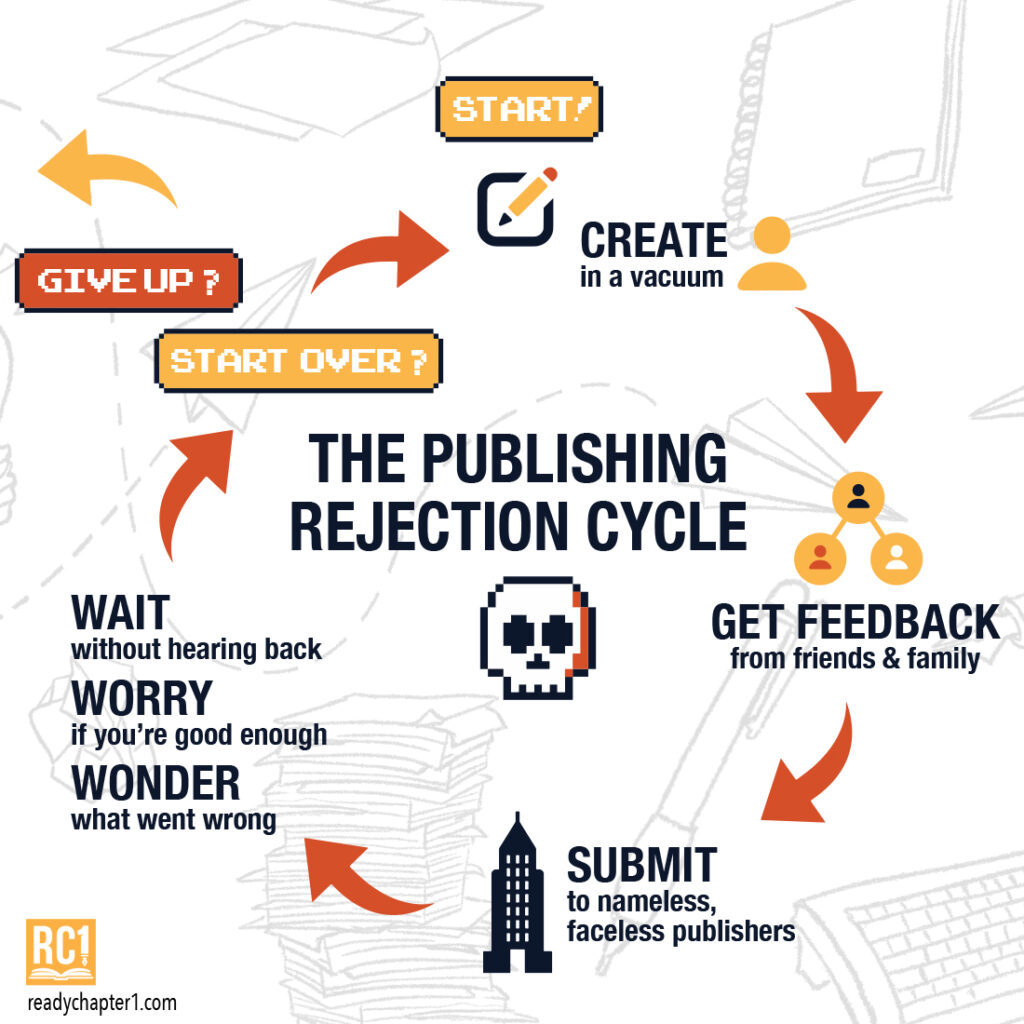Rejection stings, no matter how it comes. Here are a few of the things I’ve heard from editors rejecting my books.
-
- “Not quite right for our list.”
- “I did not connect with the main character.”
- “The concept seemed a little too thin.”
- Worst of all, the sound of chirping crickets as my inbox remains empty.
Rejection can be quick and direct. It can flow with flowery language, heaping praise on the writer. Either way, the result is the same for every rejection in the publishing industry (and beyond). For whatever reason, that gatekeeper is not interested in pursuing your project. But don’t hate on rejection just yet. With the exception of item #1 on this list, here are 10 ways you can leverage your latest rejection toward your future success.
1. Give up. As the old adage goes… if at first you don’t succeed, pick up your ball and glove and go play elsewhere. The industry is impossible. The gatekeepers are snobs. Your genius is misunderstood. If that’s the way you genuinely feel, perhaps it would be a good idea to give up for a while. But most writers I know, deep down, understand that breaking in to the publishing industry requires thick skin, long hours, and an indomitable spirit. Let’s assume that’s you and reject this option.
2. Make rejection your goal. I have a writing friend who said it was her goal to achieve 100 rejections in a year. While that may sound like masochism, the underlying principle is a lil’ bit genius. One hundred rejections means 100 submissions at the very minimum. This writer has set herself up to locate 100 editors at various publishing houses who might be the right fit for her manuscript. She gave herself permission to spend the time to research each of them, follow their specific submission guidelines, and send her work out into the world. Compare that to someone who agonized over a list of only ten editors to whom they would submit. My writer friend increased her chances of success more than 10 fold.
3. Analyze it. I like to grade every rejection I receive. Did the positive comments outweigh the negative? Did the editor seem to understand the concept? Were there any specific plot points or characters that stood out to them? How much time does it seem like that editor spent composing the rejection? Did they leave a door open for future submissions? Did I personally agree with their assessment or did I feel they missed the point completely? The quality of a rejection can be used as a barometer for an approaching storm of success. Like black clouds gathering on the horizon, the longer and more detailed your rejections, the closer you are to that lightning strike of success. (Okay, okay. I strung along the whole storm metaphor a bit too long.)
4. Print it out and start a file. I’ve personally heard at least a dozen successful, published authors describe the mountains of rejection they received prior to making it big in publishing. You want to be able to tell that story, too. And, once you are successful, the only way you get to gather ‘round all the aspiring authors is if you save the rejections in some way. Just be sure to do something original with them. I’ve heard two or three people talk about tossing their stack of rejections into a fireplace. But maybe you can use yours to create an origami garden or a papier-mâché bust of Stephen King. Maybe you make black out poems with them to share with the 4.3 million Internet followers you gained since becoming famous. At the very least, you simply pass them down to your children so they never forget that success takes hard work.
5. Wear it like a chip on your shoulder. Some of the most powerful passages I have ever written were inspired by people who said I would never make it. Michael Jordan used his outrage at being cut from his high school basketball team to propel him to train harder, practice more often, and become arguably one of the greatest athletes of all time. Rejection is a literary equivalent of getting cut from the team before tryouts even start. What could your writing become if you let rejection fuel the fire that drives you to train harder?

6. Rise above the rejection cycle. It’s estimated that 99 percent of manuscripts fall into a swirling vortex of submissions that, for one reason or another, don’t make the cut. It’s my personal belief that, to rise above, every writer must build two pillars on which to stand–Craft and Network. Craft is the quality of the work you’re submitting. Network is your reputation and who knows you exist. If you’re experiencing rejection, there’s a good chance one of those two pillars isn’t strong enough. Figure out which one and work on it.
7. Ignore it. It takes a healthy ego to even put pen to paper. And there’s something to be said for the tenacity of a person who sees every rejection as nothing more than a left swipe on the way to true love. But be careful not to confuse confidence with arrogance. The quest to find a publisher is best approached with a posture of humility. I was shocked beyond belief that three different editors were interested in what was probably the 15th manuscript I sent out on submission. Floored that it sold. If I had taken personally the cumulative rejections of the 14 previous manuscripts, I would have never made it to the one that got the yes.
8. Celebrate it. There are two professional writers in my household, and we pause to commemorate all publishing news. That means both good and bad. A great royalties statement? Dinner at our favorite restaurant. An exceptional review? Clink the glasses. Dismal sales? Clink the glasses anyways. Ditto a book rejection. Because any publishing news at all, whether good or bad, means that you are still in the game. You can still learn. You can still grow. You can still rewrite that manuscript for the seventh time. The celebration of a rejection is simply the kick-off party for the next submission.
9. Use it as a reason to ask for help. Writers are notoriously helpful. Better yet, there are hundreds of online and in-person opportunities to meet and interact with other writers. These opportunities, whether conferences, workshops, chat rooms, or social media feeds, often include successful published authors as well as the odd industry gatekeeper trolling for new material. When and if you get a chance to engage with a writer who has accomplished the level of success you would like to achieve or the industry gatekeeper who can help you achieve it, I highly suggest looking for a way to get advice about your latest rejection. (Keep in mind this may be through a paid critique, which are common at writers’ conferences.) “The last time this went out on submission,” you might say, “one editor told me they loved everything about it but simply did not connect with the main character. Do you have any suggestions on how to make a character more sympathetic?”
Pro tip: Writers love being seen as an expert on story craft. If you were to ask that question of a writer, editor, or agent, and then sat quietly to let them be the expert and share their wisdom, you would most likely make a new friend and, more importantly, a writing ally.
10. Put it in a drawer (along with the manuscript). Enough similar rejections citing similar problems likely indicate that a story needs revision. But the day to revise is not the day that you receive the rejection. The day you receive the rejection is a day to go fishing. To stop thinking about it. To find the thing that brings you joy and focus on that instead of wallowing in disappointment. Imagine if your crush told you they were simply looking for someone with a better sense of humor and all of a sudden you started texting them jokes. (I doubt it would go very well.) A formal rejection means no thank you, not now, please move on. I recommend letting a manuscript sit on the shelf for 5 to 6 months once you are certain it needs revision. After that, feel free to open it back up and try again.
11. Bonus – as I was finishing this article, I ran into a friend of mine who does sales. Big, multi-million dollar projects. And yet he gets rejected daily as part of his job. I asked him how he handles rejection. I thought his response was worth sharing:
“Recognize that your personal value is not tied to the rejection. The solution you have to offer just isn’t the right one for that person at that time. Commit to trying again, even if you need to take a moment before you do.”
Let’s keep in touch
Cool stuff is happening on the regular! Sign up to be in the know.
We respect your privacy.




